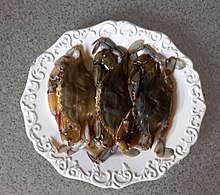Soft-shell crab


Soft-shell crab is a culinary term for crabs that have recently molted their old exoskeleton and are still soft.[1] Soft-shells are removed from the water as soon as they molt to prevent any hardening of their shell.[2] This means that almost the entire animal can be eaten, rather than having to shell the animal to reach the meat.[3] The exceptions are the mouthparts, the gills and the abdomen, which, though edible when shells are very soft, are usually discarded ("cleaned").[4] The remaining, edible part of the crab is typically deep fried or sautéed.[3]
In the United States, the main species is the "blue crab," Callinectes sapidus, which appears in markets from April to September.[5]
In the Deep South region of the United States, "Buster crab" is often a synonym for a plump, meaty soft-shell crab, this usage especially common in the culinary centers such as New Orleans and Charlotte. This is despite the fact that the original meaning of Buster crab referred to either a soft-shell that had yet to complete molting, or to a soft-shell that had died before being provided to a seafood vendor, and was then consumed by the crabber.[6][7]
In Japan, various species are used to make sushi such as maki-zushi or temaki-zushi.[3] The Japanese blue crab (Portunus trituberculatus) or the shore swimming crab (Charybdis japonica) is typically used.
In Italy, the soft-shell of the common Mediterranean crab is a delicacy typical of the Venetian lagoon (called moeca in the local idiom).[8]
Soft shell crabs can have the soft organs along the dorsal cavity removed during cleaning, or they can be left in for consumption. In the latter case, along the US Atlantic coast, the customer asks the vendor to leave “the mustard”, referring to the yellow orange color of the liver-analogue, and the deep orange of any roe in a female crab.[9]
See also
- List of crab dishes
- List of seafood dishes

References
| Wikimedia Commons has media related to Soft-shell crab. |
- ↑ CiCi Williamson, Garry Pound & Willard Scott (2008). "Shellfish and fish". The Best of Virginia Farms Cookbook and Tour Book: Recipes, People, Places. Menasha Ridge Press. pp. 60–87. ISBN 978-0-89732-657-5.
- ↑ Thompson, Fred (2010). Crazy for Crab: Every Thing You Need to Know to Enjoy Fabulous Crab at Home. ReadHowYouWant.com. p. 7. ISBN 978-1-45876-388-4. Retrieved 15 January 2015.
- 1 2 3 Ole G. Mouritsen (2009). "Sushi à la carte". Sushi: Food for the Eye, the Body and the Soul. Springer. pp. 202–250. ISBN 978-1-4419-0617-5.
- ↑ Tracy Barr (2011). "Soft-shell crabs". Cast Iron Cooking For Dummies. John Wiley & Sons. pp. 137–138. ISBN 9781118053188.
- ↑ Delilah Winder & Jennifer Lindner McGlinn (2006). "Fried soft-shell crab". Delilah's Everyday Soul: Southern Cooking with Style. Running Press. pp. 111–112. ISBN 978-0-7624-2601-0.
- ↑ Fitzmorris, Tom. "Soft-Shell Crabs". thefoodalmanac.com. Retrieved 2018-08-12.
- ↑ "BLUECRAB.INFO - Blue Crab Glossary of Terms". www.bluecrab.info. Retrieved 2018-08-12.
- ↑ "Moeca (soft-shell crab)". Parco Alimentare Venezia Orientale. Archived from the original on July 22, 2011. Retrieved January 19, 2011.
- ↑ Grant, Maryland Sea. "Chesapeake Quarterly Volume 11 Number 2: Glossary of Blue Crab Biology". www.chesapeakequarterly.net. Retrieved 2018-08-12.